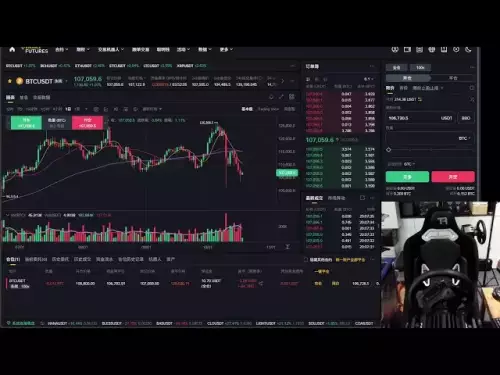-
 bitcoin
bitcoin $106975.071866 USD
-0.29% -
 ethereum
ethereum $3871.670850 USD
-0.07% -
 tether
tether $1.000261 USD
-0.01% -
 bnb
bnb $1084.417621 USD
-0.50% -
 xrp
xrp $2.348167 USD
0.82% -
 solana
solana $185.621736 USD
0.45% -
 usd-coin
usd-coin $0.999833 USD
-0.04% -
 tron
tron $0.313423 USD
0.81% -
 dogecoin
dogecoin $0.188856 USD
0.54% -
 cardano
cardano $0.630416 USD
-0.49% -
 hyperliquid
hyperliquid $36.506353 USD
2.24% -
 ethena-usde
ethena-usde $0.999584 USD
-0.01% -
 chainlink
chainlink $16.750026 USD
-0.77% -
 stellar
stellar $0.313373 USD
0.37% -
 bitcoin-cash
bitcoin-cash $465.978560 USD
-1.57%
How to set SHIB's short-term and long-term target prices? How to determine the take-profit point?
To set effective SHIB target prices, analyze market trends, use technical indicators, and monitor news; adjust take-profit points based on risk tolerance and market conditions.
Apr 29, 2025 at 04:43 pm

Setting short-term and long-term target prices for Shiba Inu (SHIB) and determining the take-profit point requires a thorough understanding of market trends, technical analysis, and risk management strategies. This article will guide you through the process of setting these targets and deciding on a take-profit point, ensuring you can make informed decisions in the volatile world of cryptocurrencies.
Understanding SHIB and Its Market Dynamics
Before setting any targets, it's crucial to understand what SHIB is and how it behaves in the market. Shiba Inu (SHIB) is a meme token that gained popularity due to its association with the Dogecoin community and its viral marketing strategies. The token's price can be highly volatile, influenced by social media trends, celebrity endorsements, and broader market movements.
To set effective target prices, you need to monitor market sentiment, trading volume, and technical indicators. These factors will help you gauge whether SHIB is in a bullish or bearish phase, which is essential for setting realistic targets.
Setting Short-Term Target Prices
Short-term target prices for SHIB are typically set for periods ranging from a few days to a few weeks. To set these targets, follow these steps:
- Analyze Recent Price Movements: Look at the recent price chart of SHIB. Identify key support and resistance levels. These levels can serve as potential short-term targets.
- Use Technical Indicators: Utilize indicators like Moving Averages (MA), Relative Strength Index (RSI), and Bollinger Bands to identify potential price movements. For instance, if the RSI indicates that SHIB is overbought, it might be a good time to set a short-term target below the current price.
- Monitor Market News: Keep an eye on news and developments related to SHIB. Positive news can drive the price up, while negative news can lead to a drop. Adjust your short-term targets accordingly.
- Set Realistic Targets: Based on the above factors, set short-term targets that are achievable. For example, if SHIB is trading at $0.00001 and you see strong support at $0.000009, you might set a short-term target at $0.0000095.
Setting Long-Term Target Prices
Long-term target prices for SHIB are set for periods ranging from several months to a year or more. These targets require a deeper analysis of broader market trends and fundamental factors. Here's how to set them:
- Analyze Long-Term Trends: Look at the long-term price chart of SHIB. Identify major trends, such as bull runs or bear markets. These trends can help you set realistic long-term targets.
- Evaluate Fundamental Factors: Consider the overall health of the cryptocurrency market, regulatory news, and the adoption rate of SHIB. For instance, if more platforms start accepting SHIB as payment, it could drive the price up in the long term.
- Use Long-Term Technical Indicators: Indicators like the 200-day Moving Average can help you identify long-term trends. If SHIB is trading above its 200-day MA, it might be in a long-term bullish trend, justifying higher long-term targets.
- Set Ambitious but Achievable Targets: Based on your analysis, set long-term targets that reflect potential growth. For example, if SHIB is trading at $0.00001 and you believe it could reach $0.00005 in a year due to increased adoption, set that as your long-term target.
Determining the Take-Profit Point
The take-profit point is where you plan to sell your SHIB to lock in profits. Determining this point involves balancing the potential for further gains with the risk of a price drop. Here's how to do it:
- Assess Your Risk Tolerance: Determine how much risk you're willing to take. If you're risk-averse, you might set your take-profit point closer to your entry price. If you're more aggressive, you might aim for higher targets.
- Use Technical Analysis: Look at key resistance levels on the price chart. These levels can serve as potential take-profit points. For instance, if SHIB is approaching a strong resistance level at $0.000015, you might set your take-profit point just below this level.
- Monitor Market Conditions: Keep an eye on market conditions and adjust your take-profit point accordingly. If the market is showing signs of a reversal, it might be wise to take profits sooner.
- Set Multiple Take-Profit Points: Consider setting multiple take-profit points to lock in profits at different levels. For example, you might set a take-profit point at $0.000012 and another at $0.000015, allowing you to secure some gains while still aiming for higher targets.
Implementing Your Strategy
Once you've set your short-term and long-term target prices and determined your take-profit points, it's time to implement your strategy. Here's how to do it:
- Use Trading Platforms: Use a reliable cryptocurrency trading platform that allows you to set limit orders. This way, you can automatically sell SHIB when it reaches your take-profit points.
- Monitor Your Positions: Regularly check the performance of your SHIB holdings against your target prices. Adjust your take-profit points if necessary based on new market data.
- Stay Informed: Keep up with the latest news and developments in the cryptocurrency space. This will help you make informed decisions about adjusting your targets and take-profit points.
FAQs
Q: How often should I review my target prices and take-profit points for SHIB?A: It's advisable to review your target prices and take-profit points at least weekly, especially in the volatile cryptocurrency market. Adjustments might be necessary based on new market data or significant news events.
Q: Can I use automated trading bots to help set and achieve my SHIB target prices?A: Yes, automated trading bots can be programmed to execute trades based on your target prices and take-profit points. However, ensure that you understand the bot's settings and risks before using them.
Q: What should I do if SHIB's price suddenly drops after I set my targets?A: If SHIB's price drops significantly, reassess your targets and take-profit points. Consider whether the drop is temporary or indicative of a longer-term trend. You might need to adjust your strategy accordingly.
Q: How can I minimize the risk of setting unrealistic target prices for SHIB?A: To minimize the risk of setting unrealistic targets, base your targets on thorough analysis of market trends, technical indicators, and fundamental factors. Avoid setting targets based solely on speculation or hype.
Disclaimer:info@kdj.com
The information provided is not trading advice. kdj.com does not assume any responsibility for any investments made based on the information provided in this article. Cryptocurrencies are highly volatile and it is highly recommended that you invest with caution after thorough research!
If you believe that the content used on this website infringes your copyright, please contact us immediately (info@kdj.com) and we will delete it promptly.
- Eric Trump, Crypto, and Caution: An Aniken Incident Cautionary Tale
- 2025-10-19 12:25:14
- Chainlink's Balancing Act: Bears, Whales, and Key Support Levels
- 2025-10-19 12:25:14
- Chainlink's Tightrope Walk: Bears, Bulls, and the $16 Support
- 2025-10-19 12:30:16
- Arthur Hayes' Maelstrom: A $250M Crypto Buyout Spree Targeting Family Offices
- 2025-10-19 12:30:16
- Decoding Pet Pain: Vet Talk on Misbehaving Pets and Hidden Aches
- 2025-10-19 12:35:11
- Bitcoin, Altcoins, and Crypto Outlook: Navigating Q4 2025's Potential Explosion
- 2025-10-19 12:35:11
Related knowledge

Practical parameter settings for a Bitcoin multi-timeframe moving average system
Sep 18,2025 at 10:54pm
Optimizing Timeframe Combinations for Bitcoin Trading1. Selecting appropriate timeframes is crucial when building a multi-timeframe moving average sys...

How can I filter out false breakouts in Dogecoin high-frequency trading?
Sep 22,2025 at 01:00am
Understanding False Breakouts in Dogecoin Trading1. A false breakout occurs when Dogecoin's price appears to move beyond a defined support or resistan...

Techniques for identifying tops and bottoms in the Bitcoin on-chain NVT model
Sep 20,2025 at 07:54pm
Understanding the NVT Model in Bitcoin Analysis1. The Network Value to Transactions (NVT) ratio is often described as the 'P/E ratio' of the cryptocur...

What does the surge in open interest in Bitcoincoin futures mean?
Sep 20,2025 at 11:18pm
Understanding the Surge in Dogecoin Futures Open Interest1. A surge in open interest within Dogecoin futures indicates a growing number of active cont...

How can I use the Ethereum USDT premium to gauge market sentiment?
Sep 18,2025 at 11:55pm
Understanding the Ethereum USDT Premium1. The Ethereum USDT premium refers to the price difference between USDT (Tether) traded on Ethereum-based plat...

What should I do if Ethereum staking yields decline?
Sep 20,2025 at 06:18am
Understanding the Causes Behind Declining Ethereum Staking Yields1. The Ethereum network transitioned to a proof-of-stake consensus mechanism with the...

Practical parameter settings for a Bitcoin multi-timeframe moving average system
Sep 18,2025 at 10:54pm
Optimizing Timeframe Combinations for Bitcoin Trading1. Selecting appropriate timeframes is crucial when building a multi-timeframe moving average sys...

How can I filter out false breakouts in Dogecoin high-frequency trading?
Sep 22,2025 at 01:00am
Understanding False Breakouts in Dogecoin Trading1. A false breakout occurs when Dogecoin's price appears to move beyond a defined support or resistan...

Techniques for identifying tops and bottoms in the Bitcoin on-chain NVT model
Sep 20,2025 at 07:54pm
Understanding the NVT Model in Bitcoin Analysis1. The Network Value to Transactions (NVT) ratio is often described as the 'P/E ratio' of the cryptocur...

What does the surge in open interest in Bitcoincoin futures mean?
Sep 20,2025 at 11:18pm
Understanding the Surge in Dogecoin Futures Open Interest1. A surge in open interest within Dogecoin futures indicates a growing number of active cont...

How can I use the Ethereum USDT premium to gauge market sentiment?
Sep 18,2025 at 11:55pm
Understanding the Ethereum USDT Premium1. The Ethereum USDT premium refers to the price difference between USDT (Tether) traded on Ethereum-based plat...

What should I do if Ethereum staking yields decline?
Sep 20,2025 at 06:18am
Understanding the Causes Behind Declining Ethereum Staking Yields1. The Ethereum network transitioned to a proof-of-stake consensus mechanism with the...
See all articles





















![[4K 60fps] Astral by oc3andark (1 Coin) [4K 60fps] Astral by oc3andark (1 Coin)](/uploads/2025/10/19/cryptocurrencies-news/videos/k-fps-astral-ocandark-coin/68f438453fa33_image_500_375.webp)




















































